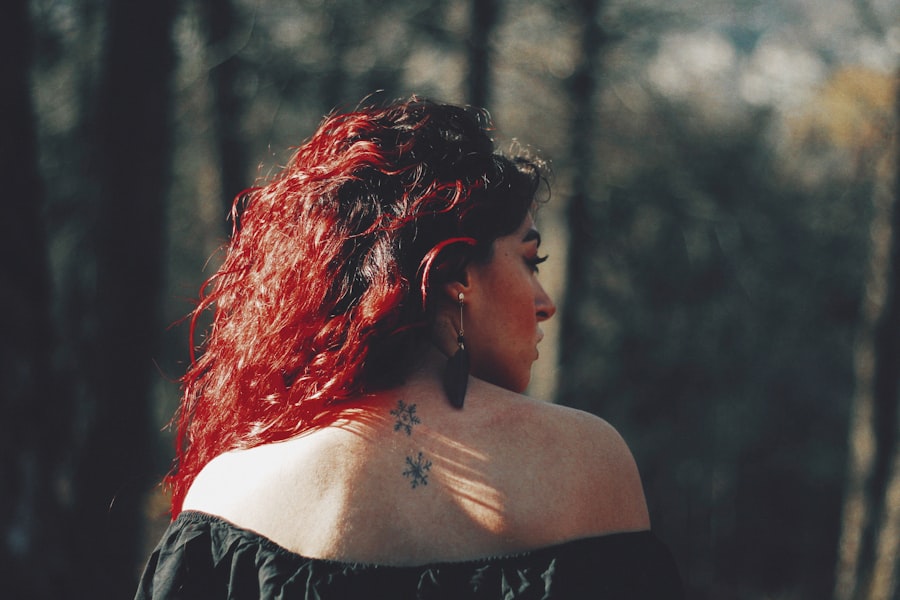Hippie fashion emerged in the 1960s as a countercultural movement rejecting mainstream consumerism and materialism. Influenced by anti-war and civil rights movements, as well as psychedelic music and art, this style reflected a desire for peace, love, and freedom. Characterized by a relaxed and natural aesthetic, hippie fashion featured loose-fitting clothing, colorful patterns, and a blend of ethnic and vintage influences.
It also challenged traditional gender norms, with both men and women adopting unisex clothing and long hairstyles. The 1969 Woodstock music festival became an iconic symbol of the hippie movement, showcasing fashion elements like fringed vests, bell-bottom jeans, tie-dye shirts, and flower crowns. As the 1970s approached, hippie fashion evolved to incorporate bohemian and ethnic styles.
Despite changes over time, it has remained a symbol of rebellion, individuality, and rejection of societal norms. Hippie fashion continues to influence modern style, emphasizing comfort, self-expression, and a connection to nature. Its legacy is evident in contemporary bohemian and festival fashion trends.
The history of hippie fashion demonstrates the power of clothing as a form of self-expression and a reflection of social and cultural movements.
Key Takeaways
- Hippie fashion emerged in the 1960s as a rejection of mainstream societal norms and a celebration of freedom and individuality.
- Key elements of hippie fashion include flowing and loose-fitting clothing, tie-dye patterns, bell-bottom pants, fringe, and natural materials such as cotton and hemp.
- Embracing bohemian style involves incorporating elements of hippie fashion, such as floral prints, peasant blouses, and layered jewelry, into a modern wardrobe.
- Modern interpretations of hippie fashion can be seen in the use of sustainable and eco-friendly materials, as well as in the incorporation of vintage and thrifted pieces.
- Embracing sustainable and ethical fashion within the hippie lifestyle involves supporting brands that prioritize fair labor practices, use organic and recycled materials, and minimize environmental impact.
Key Elements of Hippie Fashion
The Hippie Wardrobe
The hippie wardrobe is all about comfort and practicality. Flowing silhouettes, natural fabrics, and vibrant colors and patterns are key elements of this style. Loose-fitting clothing like peasant blouses, maxi dresses, and wide-leg pants are staples of the hippie wardrobe, allowing for freedom of movement and a relaxed vibe.
Accessories and Beauty
Accessories play a crucial role in hippie fashion, adding a bohemian touch to any outfit. Headbands, beaded jewelry, and fringe bags are popular choices. Footwear is typically comfortable and practical, with sandals, moccasins, and clogs being popular options. When it comes to hairstyles, long, flowing locks were a hallmark of hippie fashion, with both men and women embracing natural textures and their hair’s natural beauty.
Sustainability and Ethics
The hippie fashion movement was also characterized by a focus on sustainability and ethical practices. Many hippies embraced DIY culture, creating their own clothing and accessories from recycled materials or handcrafted items from local artisans. This emphasis on sustainability and ethical fashion has continued to be a key element of modern interpretations of hippie fashion.
Embracing Bohemian Style

The bohemian style is closely related to hippie fashion, drawing inspiration from the same principles of freedom, self-expression, and a connection to nature. Bohemian fashion is characterized by its relaxed and romantic aesthetic, incorporating elements such as flowing silhouettes, vintage-inspired prints, and a mix of textures and layers. Key pieces in the bohemian wardrobe include maxi dresses, peasant blouses, embroidered tunics, and wide-brimmed hats, creating a look that is both effortless and chic.
Bohemian style also embraces a mix of influences from around the world, incorporating elements such as ethnic prints, tribal jewelry, and handcrafted textiles. This global perspective reflects the bohemian spirit of wanderlust and a love for adventure. Accessories play a key role in bohemian fashion, with items such as statement earrings, layered necklaces, and fringe bags adding a touch of whimsy to any outfit.
In recent years, bohemian style has experienced a resurgence in popularity, with many fashion designers drawing inspiration from its romantic and free-spirited aesthetic. The bohemian look has become a staple at music festivals and has been embraced by celebrities and influencers for its effortless and laid-back vibe. Embracing bohemian style is a way to connect with the spirit of the hippie movement and express a love for individuality and creativity through fashion.
Modern Interpretations of Hippie Fashion
| Modern Interpretations of Hippie Fashion | Key Metrics |
|---|---|
| Bohemian Clothing | Increasing popularity in fashion industry |
| Flowy Dresses and Skirts | Rising demand among young adults |
| Embroidered Tops | High sales in festival fashion market |
| Tie-Dye Patterns | Growing trend in streetwear and casual wear |
| Layered Jewelry | Steady increase in online searches and sales |
Modern interpretations of hippie fashion continue to embrace the key elements of the original movement while incorporating contemporary trends and influences. The rise of sustainable and ethical fashion has become an important aspect of modern hippie style, with an emphasis on eco-friendly materials, fair trade practices, and supporting local artisans. Many modern hippie brands prioritize transparency in their supply chain and production processes, ensuring that their clothing is made with respect for people and the planet.
In addition to sustainability, modern hippie fashion also incorporates elements of street style and high fashion, creating a more polished and elevated look while still maintaining its free-spirited aesthetic. Designers have reimagined classic hippie pieces such as tie-dye shirts, fringe vests, and embroidered denim with a modern twist, making them relevant for today’s fashion landscape. The influence of social media has also played a role in shaping modern interpretations of hippie fashion, with influencers and style icons embracing the bohemian look and sharing it with a global audience.
The rise of music festivals such as Coachella has also contributed to the popularity of modern hippie fashion, with attendees embracing a mix of vintage-inspired pieces, eclectic accessories, and a carefree attitude. The festival scene has become a platform for self-expression through fashion, with attendees using their outfits as a form of creative expression. Modern interpretations of hippie fashion continue to evolve while staying true to the original spirit of peace, love, and freedom.
Embracing Sustainable and Ethical Fashion
One of the most important aspects of hippie fashion is its emphasis on sustainability and ethical practices. The original hippie movement rejected mainstream consumerism and embraced a DIY ethos that prioritized recycling and repurposing materials. This commitment to sustainability has continued to be a key element of modern interpretations of hippie fashion.
Many contemporary brands that draw inspiration from hippie style prioritize eco-friendly materials such as organic cotton, hemp, and recycled fibers. They also prioritize fair trade practices to ensure that their clothing is made under ethical working conditions. In addition to sustainable materials and production practices, many modern hippie brands also prioritize transparency in their supply chain.
This means providing information about where their clothing is made, who makes it, and under what conditions. By supporting brands that are committed to sustainability and ethical practices, consumers can embrace the spirit of hippie fashion while making a positive impact on the environment and supporting fair labor practices. Embracing sustainable and ethical fashion is not only good for the planet but also for personal style.
By choosing clothing that is made with care for people and the environment, individuals can feel good about what they wear while expressing their values through their fashion choices. Sustainable and ethical fashion is an important aspect of modern interpretations of hippie style that reflects the movement’s original commitment to peace, love, and harmony with nature.
How to Incorporate Hippie Fashion into Your Wardrobe

Incorporating hippie fashion into your wardrobe is a fun way to embrace individuality and express your personal style. Start by incorporating key pieces such as flowy maxi dresses, bell-bottom jeans, peasant blouses, and tie-dye shirts into your wardrobe. These versatile pieces can be mixed and matched to create a variety of looks that reflect the free-spirited aesthetic of hippie fashion.
Accessories play a key role in hippie fashion, so consider adding items such as fringe bags, beaded jewelry, floppy hats, and statement sunglasses to your collection. These accessories can add a bohemian touch to any outfit and help you embrace the carefree vibe of hippie style. When it comes to footwear, opt for comfortable options such as sandals, moccasins, or clogs that allow for freedom of movement while adding a touch of bohemian flair to your look.
Embracing natural textures such as leather or suede can also add an earthy element to your outfit. Incorporating hippie fashion into your wardrobe is all about embracing individuality and expressing your personal style through relaxed silhouettes, vibrant colors, and eclectic accessories. Whether you’re drawn to the romantic aesthetic of bohemian style or the laid-back vibe of festival fashion, there are endless ways to incorporate hippie fashion into your wardrobe.
Embracing the Hippie Lifestyle through Fashion
Embracing the hippie lifestyle through fashion is about more than just clothing; it’s about embodying the values of peace, love, and freedom in every aspect of your life. One way to do this is by supporting sustainable and ethical fashion brands that prioritize eco-friendly materials and fair trade practices. By choosing clothing that aligns with your values, you can make a positive impact on the environment while expressing your commitment to peace and harmony.
Another way to embrace the hippie lifestyle through fashion is by embracing a DIY ethos. Consider learning how to mend or upcycle clothing to give new life to old pieces or creating your own accessories from recycled materials. This hands-on approach not only allows you to express your creativity but also reflects the original spirit of the hippie movement.
In addition to supporting sustainable brands and embracing DIY culture, you can also embody the hippie lifestyle through your shopping habits. Consider shopping at thrift stores or vintage shops to find unique pieces that reflect the eclectic aesthetic of hippie fashion while reducing your environmental impact. Embracing the hippie lifestyle through fashion is about more than just following trends; it’s about embodying the values of peace, love, and freedom in every aspect of your life.
By supporting sustainable brands, embracing DIY culture, and shopping consciously, you can make a positive impact on the world while expressing your personal style through clothing.
If you’re interested in learning more about hippie fashion, you should check out this article on flatsoncondor.com. They have a great piece on the history of hippie fashion and how it has evolved over the years. It’s a fascinating read for anyone interested in the cultural impact of hippie style and how it continues to influence fashion today.
FAQs
What is hippie fashion?
Hippie fashion refers to the clothing and style trends associated with the counterculture movement of the 1960s and 1970s. It is characterized by a relaxed and bohemian aesthetic, often incorporating elements such as tie-dye, fringe, bell-bottoms, and natural materials.
What are some key elements of hippie fashion?
Key elements of hippie fashion include tie-dye patterns, flowing and loose-fitting garments, peasant blouses, bell-bottom pants, headbands, sandals, and natural accessories such as beads and feathers.
What influenced hippie fashion?
Hippie fashion was influenced by a variety of sources, including the anti-establishment and anti-war sentiments of the counterculture movement, as well as a desire to reject mainstream consumerism and embrace a more natural and free-spirited lifestyle.
Is hippie fashion still relevant today?
Elements of hippie fashion continue to influence contemporary style, with designers and brands often incorporating bohemian and retro-inspired looks into their collections. Many individuals also continue to embrace hippie fashion as a form of self-expression and a rejection of mainstream trends.
Where can I find hippie fashion today?
Hippie fashion can be found in specialty boutiques, vintage stores, and online retailers that cater to bohemian and retro styles. Additionally, many mainstream fashion brands offer pieces that incorporate elements of hippie fashion.




